In the world of dog training, food drive refers to a dog’s motivation to work for food. Think of it as your dog’s eagerness to earn a tasty treat in exchange for good behaviour.
This can be one of the most powerful tools in dog training. It goes beyond just getting your dog to listen; it creates a bond that makes your dog want to train with you.
When dogs are motivated by food, they do not just obey commands—they actively engage in and enjoy the training process.
Why Food Drive Matters In Training
Food drive refers to a dog’s motivation and enthusiasm when you use food as a reward. This means that the dog is eager and excited to work for food, making it a powerful tool for training and behaviour management.

Here’s what food drive looks like in practical terms:
- Excitement and focus: Dogs with a high food drive show noticeable excitement and focus when food is involved. For instance, they might exhibit eager behaviours during training sessions, such as jumping, barking, or quickly paying attention to commands. This eagerness helps keep their focus on the task at hand.
- Quick learning and response: Dogs with strong food drive learn commands and tricks more quickly. They are more likely to respond promptly to cues because they anticipate a tasty reward. For example, a dog might quickly sit, stay, or come when asked, knowing that a treat will follow.
- Engagement in training: Training sessions become more engaging with a dog that has a high food drive. The dog’s enthusiasm for the food makes it more willing to participate actively and consistently, making training more enjoyable for both the dog and the owner.
- Increased motivations: A dog with a high food drive will be motivated to perform various behaviours, even in challenging or distracting environments. For example, a dog might stay focused on its training exercises at a busy park if it is highly motivated by the food reward. Read more about motivators and how they play a crucial role in training- here.
- Positive reinforcement: Food drive enhances the effectiveness of positive reinforcement. When you use food as a reward, the dog associates good behaviour with a positive outcome, reinforcing the behaviour you want to encourage. For example, rewarding a dog with a treat for coming when called strengthens their recall ability.
In summary, a dog with a high food drive is highly motivated by food, showing excitement, quick learning, and active engagement during training. It makes food valuable for reinforcing positive behaviours and achieving training goals.
Other Benefits of Building Food Drive
Building a strong food drive offers several other benefits beyond making training sessions easier. Here’s how it can positively impact your dog:
- Weight management: With a strong food drive you can enforce structured meal times and controlled portions. It prevents overfeeding and reduces unnecessary snacking.
- Reduced behavioural issues: Dogs with a high food drive are generally more active and engaged. They enjoy training and are less likely to develop boredom-related issues or unwanted behaviours.
- Stronger bonding: A robust food drive enhances the bond between you and your dog. They learn to see you as a source of rewards and fun, which fosters trust and cooperation.
A robust food drive enhances the bond between you and your dog. They learn to see you as a source of rewards and fun, which fosters trust and cooperation.
Why Some Dogs Lack Food Drive

Not every dog has a strong food drive, which we can often trace back to common mistakes owners make. Here are some reasons why some dogs might lack it:
- Not liking the treats: If your dog seems to be refusing treats, try swaping them for a different type of snack. Use meatier treats like our favourite MyDog Nutrition Rodi sausages– a training snack packed full of fresh, nutritious ingredients, including proteins, vitamins and minerals.
- Overfeeding: If we give dogs too much food or treats, they may lose interest in additional food. When dogs are full, they are less motivated to work for more treats.
- Constant grazing: Allowing dogs to graze throughout the day can decrease their food drive. If food is always available, dogs don’t need to eat or work for it when offered.
- Too many extras: Adding extra items like chicken or rice to a dog’s meals can make their regular kibble seem less appealing. Dogs may wait for these tastier options rather than eating their regular food.
Your dog’s food drive and training efforts should improve as you work on avoiding these issues. Of course, a good food drive isn’t much use without proper training, which you can do with the help of our app!
How to Develop Food Drive in Your Dog
Building your dog’s food drive is essential for successful training. One great strategy is to use their entire meal as training rewards instead of feeding it all in a bowl. It keeps them engaged and motivates them to earn their food. If your dog doesn’t have a high food drive, this method can help by making them hungry enough to work for their meal.

Here’s how to build and use their food drive:
- Use meal portions as treats: Replace traditional bowl feeding with training exercises. Reward your dog with a portion of their meal every time they perform a behaviour like “sit” or “stay.”
- Create hunger for motivation: When your dog is a little hungry, it will be more eager to respond to commands, which helps make training more effective.
- Skip extra treats: Remove unnecessary snacks and edible toys that may dull their interest in their main food. Focus on using mealtime for training.
- Set a schedule: Stick to regular feeding times, and if your dog doesn’t eat, remove the food after 10 minutes. It creates a sense of urgency for the next meal.
These tips will create a structured approach to managing your dog’s food intake and drive. It’s a great way to help your dog be more engaged and learn quicker.
Connecting to Motivation and Training Success
Building your dog’s food drive connects back to understanding motivators. As we discussed, knowing what drives your dog—food, play, or affection—allows you to create the most effective training plan.

When food is a primary motivator, it becomes a tool that can make training easier, more fun, and more rewarding for you and your dog.
Achieve Incredible Training Results with Dogit
A food drive can transform your dog’s training experience. At Dogit, we offer a range of lessons to help you build this drive and achieve amazing results.
Check out our app’s programs to discover new ways to connect with your dog and make training a joyful experience.

WEEKLY NEWSLETTER
Lorem ipsum dolor sit amet consectetur. Viverra sed eleifend at nibh fermentum. Tortor imperdiet penatibus aliquam lorem pellentesque.



